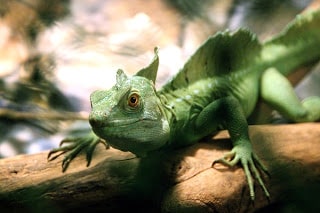 |
| About the Basilisk, a lizard that is good at running on water |
This lizard can be recognized by looking at its distinctive shape. Its body is slender with a very long tail. The skin of the scales is predominantly brown or green.
On the back of its head there is a short protrusion that is broad and resembles a bird's comb. There are four species of basilisks known to man and all of them are categorized in the genus Basiliscus.
About The Basilisk, A Lizard That Is Good At Running On Water
It is named the basilisk lizard because in European mythology, there is a monster named Basilisk which is said to be able to vomit deadly poison.
The Basilisk monster is said to have the body and wings of a dragon, but has a head that has protrusions that resemble a comb like a chicken.
 |
| About the Basilisk, a lizard that is good at running on water |
Because the basilisk lizard in the real world has protrusions that resemble a comb, the name basilisk is also used to describe the animal in question.
However, unlike the mythological version of the Basilisk animal, the basilisk in the real world is not poisonous and harmless to humans.
The habitat of the basilisk is a forest located around a river. This lizard is a diurnal animal that spends most of its time on the ground foraging and sunbathing.
When night falls, this lizard will climb trees to a height of twenty meters so that it can sleep soundly. The main food for the basilisk is insects and small animals. As well as animals, the basilisk also wants to eat fruit and flowers.
Basilisks usually walk on four legs like ordinary lizards. However, when it meets its enemy on land, this lizard can run fast with only its two hind legs. When running, the hind legs of the basilisk make a circular motion like a person pedaling a bicycle.
 |
| About the Basilisk, a lizard that is good at running on water |
Basilisk can run at speeds of up to 11 km / hour. Other sources say that this lizard can run up to 24 km / hour. Basilisk can walk not only on the ground, but also on the surface of the water. Thanks to the special scales on its hind legs, the basilisk can flow over water without sinking.
Due to its ability to walk on water, the basilisk is also known as the Jesus Christ lizard. The reason is that in the Christian story, Jesus is said to have walked on water.
The distance that the basilisk can travel across the water's surface depends largely on its weight. The lighter the weight of the basilisk, the farther it can cover when running on water.
The tiny basilisk lizard can run on water up to 20 meters. In contrast, the larger basilisk lizard can run only a few meters above water.
If the basilisk can no longer run on water, it can continue its journey by swimming. Basilisk is an excellent swimmer and can stay underwater for up to 30 minutes.
Read More: About Thorny Devil, Desert Monsters with Sharp Scales
With its ability to swim too, the basilisk can catch aquatic animals such as fish and freshwater shrimp for food.
Apart from running and swimming, the basilisk can also protect itself by disguising itself in secret because the scales are similar in color to plants or soil.
Often gets angry with other male
 |
| About the Basilisk, a lizard that is good at running on water |











0 comments